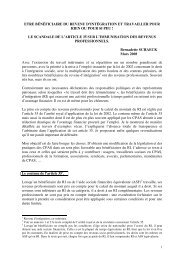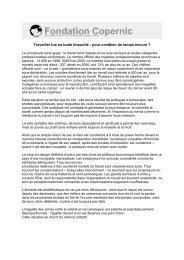Awra Amba RJ 300612 EN - Contacter un comité local d'Attac
Awra Amba RJ 300612 EN - Contacter un comité local d'Attac
Awra Amba RJ 300612 EN - Contacter un comité local d'Attac
Create successful ePaper yourself
Turn your PDF publications into a flip-book with our unique Google optimized e-Paper software.
<strong>Awra</strong> <strong>Amba</strong>, a current experiment of utopian socialism<br />
slightly more educated than women, the difference being only between 1 and 2 %. Two men and two<br />
women have a baccalaureate degree, a woman a bachelor degree and two men a master degree.<br />
The second survey concerns only the heads of household in 2008 (Ya08/91), i.e. 53 men and 34<br />
women. It is therefore more representative of adults. 85 % of heads of household are literate,<br />
whereas 30 % of adults only are literate in Ethiopia in 2005-2010, i.e. 18 % of women and 42 % of<br />
men (Unicef, 2012). In <strong>Awra</strong> <strong>Amba</strong>, the rate of literate women is clearly lower than that of men, but<br />
still remains high (68 against 96 %), 38 % of women being only able to read and write (against 57 %<br />
of men), the difference between women and men being slightly lower at the higher levels (29 against<br />
40 %).<br />
Figure 13:<br />
Distribution in % of educational level by sex in general population of <strong>Awra</strong> <strong>Amba</strong> from<br />
7 years (Atnafu, 2005/63), among household heads of <strong>Awra</strong> <strong>Amba</strong> (Yassin, 2008/91)<br />
and among the adult population of Amhara region (CSA, 2006).<br />
The comparison of the distributions of educational level in general population and among heads of<br />
household, i.e. of the results of both surveys, shows the higher illiteracy rate in general population,<br />
where are of course the 22 % of population <strong>un</strong>der 7. When we leave out these yo<strong>un</strong>ger people, which<br />
did not yet completed the first grade of primary school and therefore when we consider only the<br />
population, which could be literate (see Figure 13), the illiteracy rate falls to 30 %. Those, who are<br />
only able to read and write, are only 25 %, i.e. about two times less than among the heads of<br />
household. Those who attended beyond the 4 th grade of primary school, i.e. the middle school and<br />
above, are far higher in number than among the heads of household. It shows well the clearly better<br />
educational level of yo<strong>un</strong>g people in comparison with adults.<br />
In 2005, two children from the comm<strong>un</strong>ity were <strong>un</strong>iversity students (At05/63). In 2007, they<br />
graduated from <strong>un</strong>iversity, while nine others were attending <strong>un</strong>iversity in different parts of the<br />
co<strong>un</strong>try (Sisay, 2007). In 2009, there were respectively five and eleven (Habtamu, 2009), and in 2010<br />
seven and ten (Jo10b). University students receive State scholarships. Two out of these seven<br />
graduates are health officers (between nurse and doctor), one is an agricultural technician, four are<br />
teachers (one at the faculty of medicine, one in short post-secondary school courses, one is the<br />
68 / 85

















